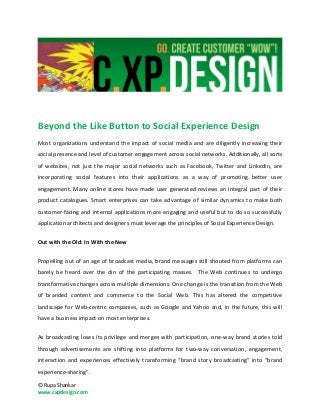Beyond the like button to social experience design
•
0 recomendaciones•299 vistas
Denunciar
Compartir
Denunciar
Compartir
Descargar para leer sin conexión

Recomendados
Recomendados
Más contenido relacionado
Destacado
Destacado (20)
Product Design Trends in 2024 | Teenage Engineerings

Product Design Trends in 2024 | Teenage Engineerings
How Race, Age and Gender Shape Attitudes Towards Mental Health

How Race, Age and Gender Shape Attitudes Towards Mental Health
AI Trends in Creative Operations 2024 by Artwork Flow.pdf

AI Trends in Creative Operations 2024 by Artwork Flow.pdf
Content Methodology: A Best Practices Report (Webinar)

Content Methodology: A Best Practices Report (Webinar)
How to Prepare For a Successful Job Search for 2024

How to Prepare For a Successful Job Search for 2024
Social Media Marketing Trends 2024 // The Global Indie Insights

Social Media Marketing Trends 2024 // The Global Indie Insights
Trends In Paid Search: Navigating The Digital Landscape In 2024

Trends In Paid Search: Navigating The Digital Landscape In 2024
5 Public speaking tips from TED - Visualized summary

5 Public speaking tips from TED - Visualized summary
Google's Just Not That Into You: Understanding Core Updates & Search Intent

Google's Just Not That Into You: Understanding Core Updates & Search Intent
The six step guide to practical project management

The six step guide to practical project management
Beginners Guide to TikTok for Search - Rachel Pearson - We are Tilt __ Bright...

Beginners Guide to TikTok for Search - Rachel Pearson - We are Tilt __ Bright...
Beyond the like button to social experience design
- 1. Beyond the Like Button to Social Experience Design Most organizations understand the impact of social media and are diligently increasing their social presence and level of customer engagement across social networks. Additionally, all sorts of websites, not just the major social networks such as Facebook, Twitter and Linkedin, are incorporating social features into their applications as a way of promoting better user engagement. Many online stores have made user generated reviews an integral part of their product catalogues. Smart enterprises can take advantage of similar dynamics to make both customer-facing and internal applications more engaging and useful but to do so successfully application architects and designers must leverage the principles of Social Experience Design. Out with the Old: In With the New Propelling out of an age of broadcast media, brand messages still shouted from platforms can barely be heard over the din of the participating masses. The Web continues to undergo transformative changes across multiple dimensions. One change is the transition from the Web of branded content and commerce to the Social Web. This has altered the competitive landscape for Web-centric companies, such as Google and Yahoo and, in the future, this will have a business impact on most enterprises. As broadcasting loses its privilege and merges with participation, one-way brand stories told through advertisements are shifting into platforms for two-way conversation, engagement, interaction and experiences effectively transforming “brand story broadcasting” into “brand experience-sharing”. © Rupa Shankar www.cxpdesign.com
- 2. Social Experience Design blends behavioral economics, experience design and media to encourage participation, optimize choices, and build engaging brand/product communities that integrate virtual and physical experiences. What is Social Experience Design? Social experience design is about the interaction between people rather than the interface between the human and the computer – and while traditional software design can well control one person’s experience with a system, you cannot predict or control how people will choose to interact with each other. The successful design of social software requires a change in mindset from traditional software development, a move from a basic focus on human-to-computer interaction to a richer appreciation of how technology can support the complexities of people-to-people interaction. Social Experience Design and Social Architecture are parallel to User Experience (UX) Design and are used for designing compelling and engaging social experiences. © Rupa Shankar www.cxpdesign.com
- 3. About CXP Design CXP Design (www.cxpdesign.com), founded by Rupa Shankar, is a platform for marketers, technologists, designers and leaders to discuss and gain a deeper understanding of cross-channel customer experience design, develop empathy for customer needs and learn how to create products and services that deliver "wow" experiences for customers. When we check into a hotel. When we shop on-line. When we buy a pair of shoes. When we get on a flight. These are experiences by which we measure brands every day. However, most companies are without the tools to purposefully design those experiences for maximum value. That’s where CXP Design comes in. Day in, day out, we live, sleep, eat, breathe and unravel the riddle that is human experience, leading to more loyal and committed customers for our clients. www.cxpdesign.com www.facebook.com/cxpdesign www.twitter.com/cxpdesign http://in.linkedin.com/groups/CXP-Design-Creating-Customer-Wow-4726523 Rupa is an Associate Director at Happiest Minds Technologies (www.happiestminds.com), a next- generation IT Services & Solutions company at the forefront of Providing Advisory, Implementation and Managed Services on Social computing, Mobility, Analytics, Business Intelligence, Cloud computing, Security and Unified Communications. At Happiest Minds, Rupa is responsible for uncovering and activating innovative digital and social engagement strategies for its clients, spearheading the development of frameworks and solutions for different industry verticals and enhancing the global go-to- market strategy. She taps into her past work as both a design practitioner and marketer to help Happiest Minds clients envision and define broad, end-to-end customer experiences. © Rupa Shankar www.cxpdesign.com
